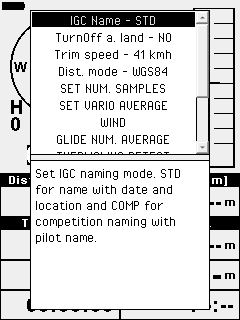Avionics
MipFly One internals
Basics
The avionics submenu of MipFly One allows for the fine-tuning of different algorithms running in the background either on the OS part of the system or on the real-time hardware. In the following paragraph, the functioning of these algorithms and the influence of each configurable parameters will be explained.

Fig. 1 Avionics menu
Glide
The glide value is the theoretical glide used for task data approximation. Generally, it should be lower than the theoretical maximum glide of your wing. Best way to determine it is to observe the instant glide you get while flying. Wind is taken into consideration for the determination of the arrival height at a certain point. If you are constantly arriving at WP with a hier altitude you should consider increasing this value. If you are arriving with a lower altitude you should consider decreasing it.
Trim Speed
The trim speed is the average speed used during a task or during a casual flight (if only waypoint navigation is employed). Wind speed and trim speed is taken into account when different task parameters are computed.
Set num. samples
The set num. samples menu lets you input the number of pressure samples that the standard firmware uses to compute vertical speed and altitude. 201 samples are fetched every second, so a setting of 201 will represent an average of 1 second, 401 an average of 2 seconds etc. Please note that this value has no influence on the real-time (instant) variometer based on acceleration. Although this feature takes advantage of the dual pressure sensors employed by MipFly One, this algorithm is certainly slower than the instant vario and is only used in conjunction with other sensors.
Please note that OK has to be pressed in order for the data to be saved and sent to the real-time hardware.
Set vario average
This is the value, in seconds, used for the average climb/sink. It can be used to determine the actual climb in a thermal or sink in a translation and compare it with the rest of the day. The recommended value is about the time needed to make 2 thermal turns.
Wind
The wind algorithm is based on a circular regression (circle fit to a set of data points) algorithm applied to the XY speeds determined from the course and ground speed. To drop out data that can result is an erroneous determination two conditions have to be met:
- a certain course change was performed in the measurement window (also called data spread)
- The RMS error of the circle fit is less than a predetermined value
Wind num. readings
This value represents how big is the history of speed-course values to be considered. You should note that there are 5 readings made every second. Increasing this value may also require to increase the value of RMS in order to compensate for the larger dataset.
Recommended 200
Wind num average
This value represents the number of distinct measurements taken into account to make a wind approximation.
Recommended 40
Wind data spread
Wind data spread value represents the minimum data spread value for which the dataset is considered for wind determination. This is used to ignore values resulted from a linear flight and only take into account values from turns or thermalling. A turn of 180 degrees will usually generate a data spread of about three times the glider speed.
Recommended 80
Wind RMS error
This is the limit value for a fit to be considered adequate. For example, if during the turn you will modify your speed, the points on the XY speed graph will no longer fit a circle, resulting in a big RMS error.
Recommended 3.5 - 4 for Wind num readings of 200
Glide num. average
This menu is used to set the number of values used to compute the average glide. Please note that one sample is taken every 200 ms, so that there are a total of 5 samples in one second.
Thermaling detect
This menu is used to set and enable automatic switch to Thermal assistant from other pages. If enable, when climb and turn are detected it switch. Instead when glider doens't turn and climb it swtich to previous page
Detect ON - Detect OFF
Activate/Deactivate thermaling detector
Saturation
Saturation value. Used to limit maximum turn integral to facilitate deactivation. Recommended 150.
Decay
Decay value. Each unit is equivalent to 5 deg/sec decay. Recommended 1
Activate Threshold
Threshold that will trigger an activate event. Recommended 80.
Deactivate Threshold
Threshold that will trigger an deactivate event. Recommended 60